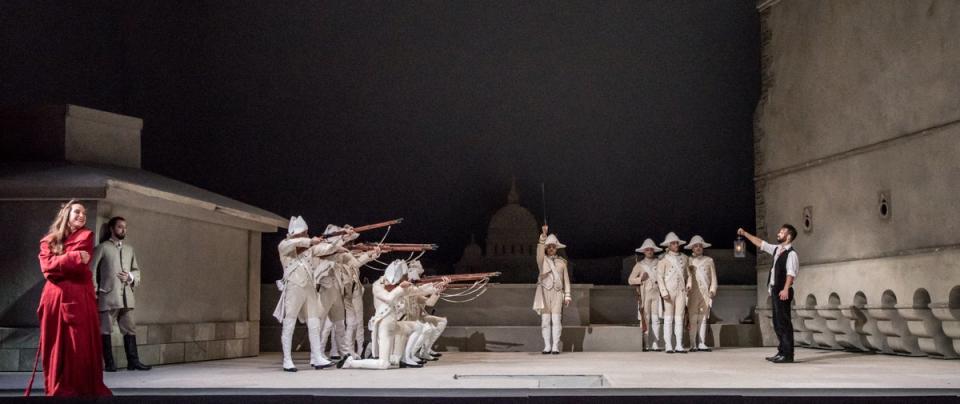Tosca - ENO at the London Coliseum review: a thrilling vision of liberation

Anyone familiar with the austere minimalism of Christof Loy’s productions will have been surprised to see his Tosca trailed as ‘stylishly traditional’, even ‘glamorous’. It may be superficially more traditional than one might have expected, but it’s certainly not an opulent spectacle in the manner of Franco Zeffirelli’s celebrated 1960s staging, and far more penetrating.
The white-walled church interior of Act I (designer Christian Schmidt) is more brightly lit than usual (Olaf Winter) and the action set right in front of us, not in a dimly lit side-chapel, with a big gain in immediacy. We were warned that because of Noel Bouley’s vocal indisposition, he would act the role of Scarpia but it would be sung from the wings by Roland Wood. That scarcely prepared us for the electrifying entrance of the police chief in the church, with Wood suddenly appearing in a box startlingly close to the front stalls.
Tosca’s identity as an opera singer is played up in her ensuing encounter with Scarpia, watched by a bemused congregation including periwigged figures of the pre-revolutionary period. Their slow-motion strutting lends an ironic touch of historicism. Other costumes range from the early 19th century (when the action is set) to the modern day.

But Scarpia’s lewd pursuit of Tosca is a performance of his own – falling on his knees, rolling in a spasm – also witnessed by an audience. In the second act, Scarpia, threatening torture, looks around for approval from his terrified henchman, Spoletta. Tosca, by contrast, is playing no role when appealing to Scarpia for mercy and loses her operatic wig. Scarpia’s palatial quarters are slowly transformed into a quasi-theatrical space by a wall-size red curtain.
The curtain reappears in Act 3 as Tosca tells Cavaradossi of the supposed letter of safe conduct she has snatched from the hand of the dead Scarpia. It becomes clear that Cavaradossi doesn’t share her illusion of freedom as reality. But is Tosca – who in many ways represents the emancipated woman of the late 19th century – merely enacting a fantasy too? The question is left tantalisingly open. Similarly, her jump from the battlements is splendidly theatrical.

Sinéad Campbell-Wallace, originally a light-lyric soprano, but one who has gravitated towards heavier roles, offers both emotional weight and tonal flexibility in a persuasive account of the title part. Adam Smith’s voice has a penetrating core which forms the basis of a stirring delivery of the role of Cavaradossi on the too infrequent occasions when he allows the tone to blossom. Wood’s menacing Scarpia was outstanding. Also effective are Lucia Lucas as the Sacristan, Msimelelo Mbali as Angelotti and John Findon as Spoletta.
Theatre provides a simulacrum of life, Loy seems to be suggesting in this thought-provoking and superbly accomplished production, impressively conducted by Leo Hussain. For Scarpia it’s the Theatre of Cruelty. For Tosca, art, life and love all coalesce in a vision of liberation no less inspiring for its futility.
London Coliseum, to November 4; eno.org

 Yahoo Finance
Yahoo Finance 